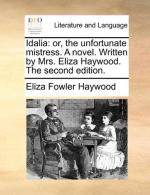|
This section contains 2,260 words (approx. 8 pages at 300 words per page) |

|
SOURCE: "The Awakening of the Eighteenth-Century Heroine: Eliza Haywood's New Women," in The CEA Critic: An Official Journal of the College English Association, Vol. 43, No. 3, March, 1981, pp. 9-13.
In the following essay, Schofield offers an analysis of Haywood's female heroines and of Haywood's role in the development of the novel. Schofield also examines ways that Haywood's works contribute to an understanding of eighteenth-century social life.
Until recent years critical studies of eighteenth-century fiction have begun with considerations of Richardson and Fielding.1 As seen from the perspective of these general histories, the eighteenth-century novel appeared all but fully developed with Richardson's Pamela in 1740. Recent scholarship, on the other hand, has produced Robert A. Day's Told in Letters: Epistolary Fiction Before Richardson (1966) and John J. Richetti's Popular Fiction Before Richardson (1966), both noteworthy contributions to the field of early eighteenth-century fiction criticism. The interest espoused by these two works is indicative...
|
This section contains 2,260 words (approx. 8 pages at 300 words per page) |

|


